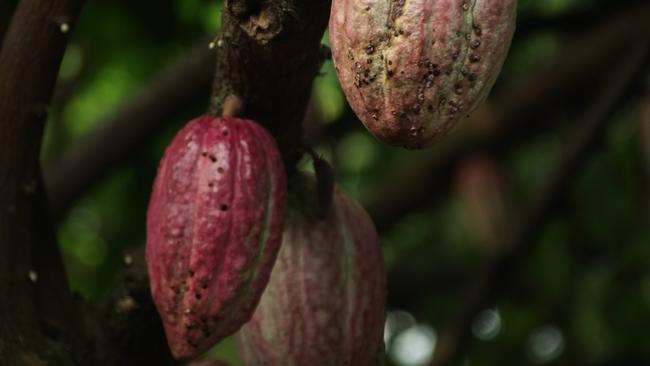From tree to bean to bars: a look inside chocolate’s main ingredient
With chocolate on everyone’s lips this weekend, let’s look at its chief ingredient, cocoa.

With chocolate on everyone’s lips this weekend, let’s look at its chief ingredient, cocoa.
Cocoa beans come from the fruit of a rainforest tree, Theobroma cacao. Thought to originate from the upper Amazon and cultivated by the Mayans and Aztecs for thousands of years, cocoa trees are now grown around the globe within 20 degrees north or south of the equator. The botanical name Theobroma is derived from the Greek for “food of the gods”.
Chocolate was introduced to Europe as a beverage by the Spanish in the 16th century and its popularity spread quickly, but as a luxury item. The first chocolate bar was made in Switzerland in 1819.
Cocoa trees are rainforest understorey plants, reaching around 5m-8m with broad, lush leaves. The flowers are produced in small clusters directly on the bark of the trunk and branches, and while each tree can produce more than 100,000 flowers, only about 0.1 per cent turn into fruit, called pods, that also project straight from the bark. The pollinators are tiny flies. The pods take about five months to ripen, developing to the size of an eggplant. The hard outer skin is yellow or orange when fully ripe, while inside, the white or violet seeds are protected by a white, mucilaginous pulp. This pulp can be eaten or made into juice, but it doesn’t taste like chocolate.
With an average 20-40 seeds or cocoa beans per fruit, it takes between 15 and 35 fruits to harvest 1kg of beans. The beans are fermented for several days, which develops the chocolate flavours, then dried and finally roasted to intensify aroma and taste. After winnowing away the husks, the high-fat “nibs” are crushed to make chocolate paste. Pressing this produces pale yellow cocoa butter (each bean contains about 45-55 per cent fat) and the solids go on to become cocoa powder. Dark chocolate contains cocoa butter, cocoa powder and sugar; milk chocolate also contains milk solids and white chocolate omits the cocoa powder.
The species Theobroma cacao contains a vast number of varieties, classified into ten groups based on geographical, morphological and genomic characteristics. Each has different pod shapes and colours and different flavour profiles, which also vary according to the terroir of where it’s grown.
One of the major challenges limiting cacao production around the world is that an estimated 40 per cent of crops are lost to pests and destructive fungal diseases. Because nearly all of global production is by small-scale farmers, disease control is often difficult or too expensive. With worldwide demand for chocolate continuing to climb, urgent research is underway to breed disease resistant varieties and efforts are being directed at teaching improved farming practices to increase yields.
Q&A
My variegated peppermint tree (Agonis flexuosa) has some foliage coming out all green. Will it revert to the regular green type? Can I halt this change? Alan Jackson, by email
Variegated forms of many trees and shrubs can start to revert to the original green species, which is genetically stronger. To counter this, promptly prune out any green branches that appear. If you leave them, the plant can revert completely over time.
Is there an all-round fertiliser for my balcony of pot plants, including orchids, happy plants, succulents, ferns and cyclamen? I’ve little money to spare. Sue Harris, by email
Controlled release prills (such as Osmocote) for pots are easy and safe but can be costly. Soluble fertilisers are excellent for pot plants but need applying more frequently. Of these, some have as little as a few per cent nitrogen (N), potassium (K) and phosphorus (P), you need to read the labels, but others such as Thrive All Purpose Soluble Fertiliser have an NPK of 25:5:8.8 and 1 teaspoon is enough for 4.5 litres of water, making it very economical. Use half strength for ferns. There’s a Flower and Fruit version with higher potassium if you want to promote blooms.

I planted both oregano and marjoram but my labels faded. How do I tell the difference? Cooking-wise are they interchangeable? Pauline Coroneo Smith, Brisbane
Closely related, they both look similar. Marjoram leaves are slightly hairier and rounder, and tend to cluster at the stem tips, while oregano leaves are more evenly spaced. Marjoram’s flavour is milder and sweeter compared to pungent and spicier oregano.
Send your questions to: helenyoungtwig@gmail.com or Helen Young, PO Box 3098, Willoughby North, NSW 2068. The best question for April wins the lightweight and compact battery Shrub Shears from Stihl worth $219.


To join the conversation, please log in. Don't have an account? Register
Join the conversation, you are commenting as Logout